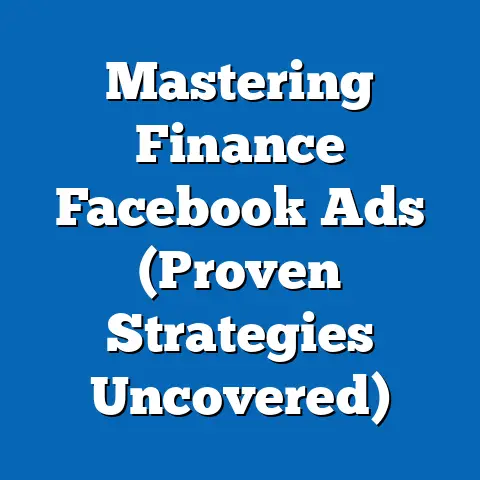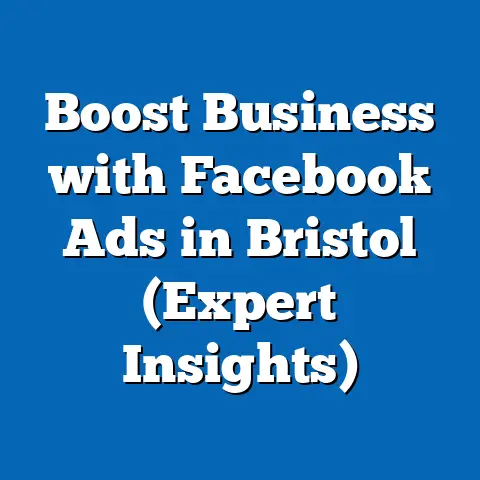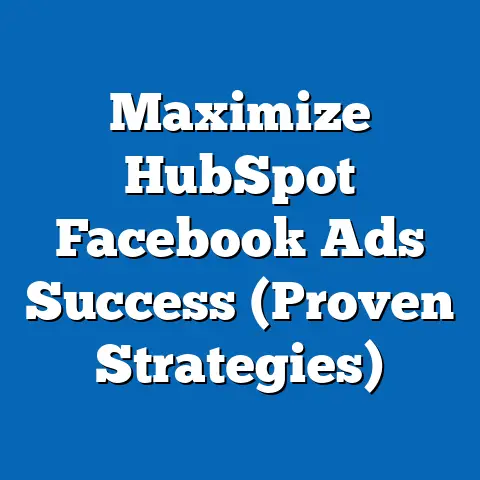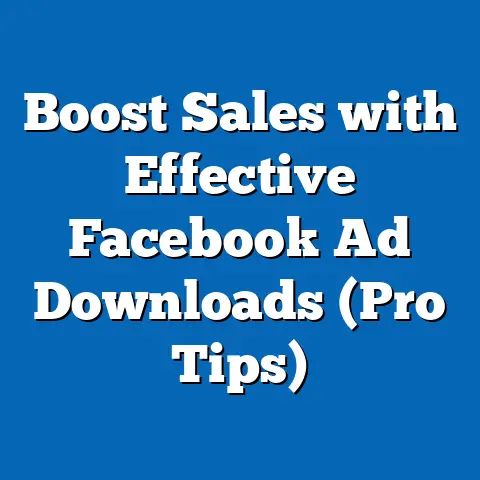Master Dynamic Creative for Facebook Ads (Expert Tips)
In an era where digital marketing is as much about efficiency as it is about creativity, the concept of energy savings extends beyond the physical realm into the digital space. Just as households and businesses strive to reduce energy consumption for cost efficiency and environmental benefits, digital advertisers aim to optimize their campaigns to save time, reduce costs, and maximize impact. Facebook’s Dynamic Creative tool represents a powerful parallel to energy-saving technologies, automating and streamlining the ad creation process to deliver tailored content to diverse audiences with minimal resource waste.
Section 1: Defining Dynamic Creative for Facebook Ads
Dynamic Creative is a feature offered by Facebook Ads Manager that allows advertisers to create multiple variations of an ad by combining different creative elements such as images, videos, headlines, descriptions, and calls-to-action (CTAs). Rather than manually crafting individual ads for testing, the tool automatically generates combinations of these assets and uses machine learning to optimize delivery to the most responsive audience segments. This results in a more personalized ad experience while reducing the manual workload for marketers.
Introduced as a response to the growing complexity of digital advertising, Dynamic Creative addresses the need for scalability and efficiency. It enables advertisers to test up to 6,250 unique ad combinations from a single setup, depending on the number of creative assets uploaded. This capability is akin to energy-efficient systems that adapt to real-time needs, ensuring resources are allocated where they are most effective.
Key characteristics of Dynamic Creative include automation, adaptability, and data-driven optimization. These features mirror the principles of energy conservation, where systems adjust based on usage patterns to minimize waste. For marketers, this translates to reduced time spent on manual testing and a sharper focus on strategic planning.
Section 2: Historical Context of Dynamic Creative in Digital Advertising
The evolution of digital advertising has been marked by a constant push for greater personalization and efficiency, much like the historical shift toward energy-saving technologies in response to resource scarcity and environmental concerns. In the early 2000s, online ads were largely static, with limited targeting capabilities and manual optimization processes. Marketers had to create and monitor multiple ad variations individually, a process that was both time-intensive and prone to human error.
Facebook’s introduction of advanced targeting options and the Ads Manager platform in the late 2000s marked a significant leap forward. By 2017, the launch of Dynamic Creative built on these advancements, leveraging machine learning to automate ad optimization at scale. This development paralleled the rise of smart energy systems, which use data analytics to optimize consumption patterns in real time.
The historical context of Dynamic Creative also ties into broader societal shifts toward digital transformation. As businesses increasingly moved online, the demand for tools that could handle large-scale, personalized advertising grew. Dynamic Creative emerged as a solution, reflecting a cultural and economic pivot toward automation and efficiency—principles that resonate with energy conservation efforts in the physical world.
Section 3: Societal Implications of Dynamic Creative
The adoption of Dynamic Creative in digital advertising has far-reaching implications for society, much like how energy-saving technologies influence environmental and economic landscapes. At its core, this tool reshapes how businesses connect with consumers, prioritizing relevance and personalization over generic messaging. This shift can enhance user experiences by delivering content that aligns with individual preferences, but it also raises concerns about privacy and data usage.
From an economic perspective, Dynamic Creative democratizes high-quality advertising by reducing the barriers to entry for small businesses. Just as energy-efficient appliances make sustainable living accessible to more households, this tool allows smaller advertisers to compete with larger brands by leveraging automation without requiring extensive resources. According to a 2022 study by Hootsuite, businesses using Dynamic Creative reported a 34% increase in ad performance compared to traditional methods, highlighting its potential to level the playing field.
However, societal implications also include the risk of over-optimization, where consumers may feel overwhelmed by hyper-targeted ads, leading to ad fatigue. Additionally, the reliance on machine learning raises ethical questions about algorithmic bias and the transparency of data-driven decisions. These challenges mirror debates in the energy sector about the balance between automation and human oversight in smart grids.
Section 4: Key Features and Benefits of Dynamic Creative
Dynamic Creative offers a suite of features designed to streamline the ad creation process while maximizing return on investment (ROI). One of its primary benefits is the ability to test multiple creative combinations simultaneously, allowing advertisers to identify winning elements without manual intervention. For instance, a single campaign can test up to 10 images, 5 headlines, and 5 descriptions, resulting in hundreds of unique ads tailored to different audience segments.
Another significant advantage is its integration with Facebook’s machine learning algorithms, which analyze performance data in real time to prioritize high-performing combinations. This adaptability ensures that ad spend is allocated efficiently, much like how energy-saving devices adjust to peak usage times to minimize costs. A 2021 report by Social Media Today found that campaigns using Dynamic Creative saw a 20-30% reduction in cost-per-acquisition (CPA) compared to static ads.
The tool also supports a variety of ad formats, including single images, carousels, and videos, catering to diverse marketing goals. This versatility allows brands to experiment with storytelling and visual styles without committing to a single approach upfront. For marketers, this translates to saved time and resources, enabling a focus on broader campaign strategy over granular ad design.
Section 5: Expert Tips for Mastering Dynamic Creative
To fully leverage Dynamic Creative, marketers must adopt a strategic approach grounded in best practices and data-driven insights. Below are expert tips to optimize its use, ensuring campaigns achieve maximum impact with minimal waste—akin to optimizing energy usage in a smart home.
1. Diversify Creative Assets for Broader Testing
When setting up a Dynamic Creative campaign, upload a wide range of images, videos, headlines, and CTAs to maximize the number of testable combinations. Ensure that assets vary in tone, style, and messaging to appeal to different audience segments. For example, pair emotional imagery with benefit-driven headlines to test which resonates more with your target demographic.
2. Leverage Audience Insights for Tailored Content
Use Facebook’s Audience Insights tool to understand the preferences and behaviors of your target audience before creating assets. Tailor headlines and visuals to match demographic trends, such as age-specific language or culturally relevant imagery. This approach ensures that Dynamic Creative has a strong foundation of relevant content to optimize, much like how energy systems are programmed based on historical usage data.
3. Monitor Performance Metrics Closely
While Dynamic Creative automates optimization, regularly review performance metrics such as click-through rate (CTR), conversion rate, and CPA to identify trends. Use the “Breakdown” feature in Ads Manager to see which combinations are driving results and refine assets accordingly. This iterative process mirrors energy audits that fine-tune systems for greater efficiency.
4. Avoid Overloading with Too Many Variations
While it’s tempting to test thousands of combinations, too many variables can dilute focus and slow down optimization. Start with a manageable number of assets (e.g., 3-5 per category) and scale up based on initial results. This balanced approach prevents resource waste, similar to how energy-saving plans prioritize impactful changes over excessive adjustments.
5. Test Across Different Objectives and Placements
Dynamic Creative works across various campaign objectives, from brand awareness to conversions, and supports multiple ad placements like Stories, Feed, and Marketplace. Experiment with different objectives and placements to uncover untapped opportunities. For instance, a video ad in Stories might outperform a static image in the Feed for younger audiences, reflecting the need for adaptability in both marketing and energy management.
6. Incorporate Seasonal and Trending Themes
Keep creative assets fresh by aligning them with seasonal events, holidays, or trending topics relevant to your audience. This strategy ensures ads remain engaging and timely, much like how energy-saving campaigns promote seasonal adjustments to heating or cooling. A 2023 survey by Sprout Social noted that 68% of consumers are more likely to engage with ads tied to current events or trends.
7. Use Retargeting to Enhance Relevance
Combine Dynamic Creative with retargeting campaigns to re-engage users who have interacted with your brand. Customize assets to reflect their previous actions, such as showcasing products they viewed or abandoned in their cart. This targeted approach maximizes relevance and efficiency, akin to smart thermostats learning user patterns to optimize temperature settings.
Section 6: Challenges and Limitations of Dynamic Creative
Despite its many benefits, Dynamic Creative is not without challenges, much like how energy-saving technologies face hurdles in adoption and implementation. One primary limitation is the loss of granular control over ad combinations. While automation streamlines the process, marketers may find it difficult to manually prioritize specific pairings or exclude underperforming elements mid-campaign.
Another challenge is the potential for creative fatigue among audiences. Even with optimization, repeatedly serving similar ad variations can lead to diminished returns over time. A 2022 study by Nielsen found that 47% of consumers reported feeling annoyed by repetitive ads, underscoring the need for fresh content updates.
Additionally, Dynamic Creative’s reliance on machine learning means it requires sufficient data to optimize effectively. For smaller campaigns with limited budgets or audiences, the tool may struggle to deliver meaningful insights quickly. This mirrors the initial investment required for energy-efficient systems, which may not yield immediate savings for smaller households.
Section 7: Comparing Dynamic Creative with Traditional Ad Testing
When compared to traditional A/B testing, Dynamic Creative offers distinct advantages in terms of scale and efficiency. Traditional methods require marketers to create and monitor individual ad variations manually, a process that can take weeks to yield actionable insights. In contrast, Dynamic Creative automates this process, testing thousands of combinations in days and optimizing delivery in real time.
However, traditional testing allows for greater control and specificity, enabling marketers to isolate variables with precision. For instance, an A/B test can focus solely on headline performance while keeping other elements constant, whereas Dynamic Creative tests multiple variables simultaneously, making it harder to pinpoint causation. This trade-off reflects the balance between automation and manual oversight seen in energy management systems.
Ultimately, the choice between Dynamic Creative and traditional testing depends on campaign goals and resources. For large-scale campaigns with diverse audiences, Dynamic Creative’s efficiency is unparalleled. For smaller, highly targeted efforts, traditional methods may offer the precision needed to fine-tune messaging.
Section 8: Broader Impacts on Marketing and Society
The widespread use of Dynamic Creative is reshaping the marketing industry by prioritizing automation and data-driven decision-making. This shift has led to a growing demand for skills in data analysis and creative strategy, as marketers must interpret performance metrics and develop assets that resonate across diverse segments. According to LinkedIn’s 2023 Jobs Report, roles related to digital advertising optimization saw a 25% increase in demand, reflecting the tool’s influence on career trends.
From a societal perspective, Dynamic Creative contributes to the ongoing dialogue about digital privacy and consumer empowerment. As ads become more personalized, consumers are increasingly aware of how their data is used, prompting calls for greater transparency and regulation. This mirrors societal debates around smart energy systems, where data collection raises concerns about surveillance and security.
Moreover, the tool’s ability to optimize ad spend efficiently aligns with broader economic trends toward sustainability. By reducing waste in digital advertising, businesses can allocate resources to other priorities, much like how energy savings enable reinvestment in renewable technologies. This parallel underscores the interconnectedness of efficiency across physical and digital domains.
Section 9: Case Studies and Real-World Applications
To illustrate the power of Dynamic Creative, consider the case of a mid-sized e-commerce brand that used the tool to boost holiday sales in 2022. By uploading 8 images, 4 headlines, and 3 CTAs, the brand tested over 100 ad combinations targeting different customer segments. Within two weeks, Dynamic Creative identified a winning combination—a festive image paired with a discount-focused headline—that drove a 40% increase in conversions compared to static ads.
Another example involves a nonprofit organization promoting environmental awareness. Using Dynamic Creative, the nonprofit tested video and image ads with messaging tailored to various age groups. The tool optimized delivery to younger audiences on Instagram Stories, achieving a 28% higher engagement rate than traditional campaigns. This success highlights how efficiency in ad delivery can amplify social impact, much like energy-saving initiatives enhance environmental outcomes.
These case studies demonstrate the versatility of Dynamic Creative across industries and objectives. They also underscore the importance of strategic asset creation and ongoing performance monitoring to maximize results, reflecting best practices in both marketing and resource management.
Section 10: Future Outlook and Uncertainties
Looking ahead, the role of Dynamic Creative in digital advertising is likely to expand as machine learning algorithms become more sophisticated. Future iterations may offer even greater customization, such as real-time asset generation based on trending topics or user interactions. This potential mirrors advancements in energy-saving technologies, where AI-driven systems are expected to predict and adapt to usage patterns with unprecedented accuracy.
However, uncertainties remain, particularly around regulatory changes and consumer sentiment. As privacy laws like the GDPR and CCPA evolve, platforms like Facebook may face restrictions on data usage, impacting the effectiveness of tools like Dynamic Creative. Additionally, growing consumer resistance to targeted advertising could necessitate a shift toward less invasive strategies, challenging the tool’s current model.
Despite these uncertainties, the core principle of efficiency—whether in energy savings or digital advertising—will likely remain a driving force. Marketers who adapt to these changes by prioritizing transparency and user-centric design will be best positioned to succeed. Similarly, ongoing innovation in energy management suggests that adaptability and foresight are key to navigating future challenges.
Conclusion
Mastering Dynamic Creative for Facebook Ads offers marketers a powerful tool to enhance efficiency, much like energy-saving technologies transform resource consumption in the physical world. By automating ad optimization and enabling large-scale testing, Dynamic Creative saves time and resources while delivering personalized content to diverse audiences. Its historical roots in the evolution of digital advertising reflect broader societal shifts toward automation and data-driven decision-making.
However, its adoption comes with challenges, from ethical concerns about data usage to the risk of creative fatigue. Expert tips—such as diversifying assets, leveraging audience insights, and monitoring performance—can help marketers navigate these hurdles and maximize impact. As the tool continues to evolve, its societal implications will shape debates around privacy, economic equity, and digital transformation.
Ultimately, Dynamic Creative represents a step toward sustainable advertising practices, aligning with the principles of efficiency and adaptability that define energy conservation efforts. While the future holds uncertainties, its potential to revolutionize marketing remains undeniable, offering a blueprint for balancing creativity and efficiency in an increasingly digital world.






